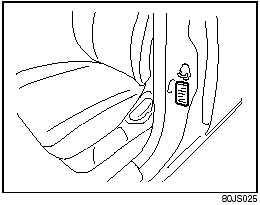Vehicle Loading

Your vehicle was designed for specific weight capacities. The weight capacities of your vehicle are indicated by the Gross Vehicle Weight Rating (GVWR), the Gross Axle Weight Rating (GAWR, front and rear) and the Vehicle Capacity Weight. The GVWR and GAWR (front and rear) are listed on the Safety Certification Label which is located below the driver’s side door latch striker. The Vehicle Capacity Weight is listed on the Tire Information Label which is located below the Safety Certification Label.
GVWR – Maximum permissible overall weight of the fully loaded vehicle (including all the occupants, accessories and cargo).
GAWR – (Front and Rear) Maximum permissible weight on an individual axle.
Vehicle Capacity Weight – Maximum permissible load weight a vehicle can carry including the weight of all the occupants, accessories and cargo.
The weight of any accessories already installed on your vehicle at the time of purchase, or that you or the dealer install after purchase, must be subtracted from the Vehicle Capacity Weight to determine how much capacity remains available for occupants and cargo. Contact your dealer for further information.
Actual weight of the loaded vehicle and actual loads at the front and rear axles can only be determined by weighing the vehicle using a vehicle scale. To measure the weight and load, try taking your vehicle to a highway weighing station, shipping company or inspection station for trucks, etc.
Compare these weights to the GVWR and GAWR (front and rear) listed on the Safety Certification Label. If the gross vehicle weight or the load on either axle exceeds these ratings, you must remove enough weight to bring the load down to the rated capacity.

WARNING:
Never overload your vehicle. The
gross vehicle weight (sum of the
weights of the loaded vehicle, driver
and passengers) must never exceed
the Gross Vehicle Weight Rating
(GVWR) listed on the Safety Certification
Label. In addition, never distribute
a load so that the weight on either
the front or rear axle exceeds the
Gross Axle Weight Rating (GAWR)
listed on the Safety Certification
Label.

WARNING:
• Always distribute cargo evenly.
• To avoid personal injury or damage to your vehicle, always secure cargo to prevent it from shifting if the vehicle moves suddenly.
• Place heavier objects on the floor and as far forward in the trunk or in the cargo area as possible.
• Never pile cargo higher than the top of the seat backs.
See also:
New for 2011
There are no significant changes for 2011. ...
Frame Hooks
SX4
Front (1)
SX4 SEDAN
Front (1)
SX4
Rear (2)
SX4 SEDAN
Rear (2)
Side (3)
Frame hooks are provided on the front (1),
rear (2) and side (3) of the vehicle. The
hooks (1) and (2) ...
Glove Box
Glove Box
To open the glove box, pull the latch lever.
To close it, push the lid until it latches
securely. If a lock is equipped on the latch
lever, lock the glove box by inserting the
key and ...
